Measuring Created Value for Suppliers and Buyers: A Decision Matrix Approach—Evidence from Slovak Enterprises
Abstract
1. Introduction
- Identification of value-creation indicators for suppliers and buyers.
- Assignment of importance to these value-creation indicators based on empirical research.
- Development of a decision matrix for measuring the value created for suppliers and buyers.
- The lack of identification of individual value-creation indicators provided to suppliers and buyers.
- The absence of a determination regarding the importance of these value-creation indicators, as perceived by suppliers and buyers.
- The absence of a method for integrating this information into a comprehensive framework for measuring value for suppliers and buyers.
2. Theoretical Framework
2.1. Value Creation in Supplier–Buyer Relationships
2.2. Measuring Value Creation: Approaches and Methodologies
2.3. Key Value-Creation Indicators in Supplier–Buyer Relationships
3. Materials and Methods
- n represents the required sample size,
- E denotes the margin of permissible error,
- N refers to the total population size,
- r is the expected proportion of relevant responses,
- Z(c/100) represents the critical value corresponding to the selected confidence level.
4. Results
4.1. Provision of Value-Creation Indicators for Suppliers
4.2. Provision of Value-Creation Indicators for Buyers
4.3. Process of Creating the Value Measurement Matrix
4.4. Significance of Value-Creation Indicators Provided to Suppliers and Buyers and Their Average Score
4.5. Importance Weights, Matrix Creation, and Value Calculation
5. Discussion
5.1. Implications for Theory
5.2. Implications for Managers and Policymakers
5.3. Limitations of the Study and Future Research Directions
6. Conclusions
Author Contributions
Funding
Institutional Review Board Statement
Informed Consent Statement
Data Availability Statement
Conflicts of Interest
Abbreviations
| SRM | Supplier Relationship Management |
| B2B | Business to Business |
| ROR | Return on Relationships |
| MCDM | Multi-criteria decision-making |
| AHP | Analytical Hierarchy Process |
| TOPSIS | Technique for Order Preference by Similarity to Ideal Solution |
| DMM | Decision Matrix Method |
| DT | Digital Transformation |
Appendix A
| Question | Answer |
| What value (indicators) does your company provide to its suppliers? Please select from the following indicators. (Mark all applicable options). | List of the value-creation indicators for suppliers (see Figure 1). |
| How important are the individual indicators (related to the previous question) to your company? Please rate their importance on a scale from 1—not important at all to 5—very important. | 1—No importance, 2—More unimportant than important, 3—Neutral, 4—More important than unimportant, 5—High importance. |
| What value (indicators) does your company provide to its buyers? Please select from the following indicators. (Mark all applicable options). | List of the value-creation indicators for buyers (see Figure 2). |
| How important are the individual indicators (related to the previous question) to your company? Please rate their importance on a scale from 1—not important at all to 5—very important. | 1—No importance, 2—More unimportant than important, 3—Neutral, 4—More important than unimportant, 5—High importance. |
References
- Anderson, J. C., Narus, J. A., & Narayandas, D. (2008). Business market management: Understanding, creating, and delivering value (3rd ed.). Person. [Google Scholar]
- Aruldoss, M., Lakshmi, T. M., & Venkatesan, V. P. (2013). A survey on multi criteria decision making methods and its applications. American Journal of Information Systems, 1(1), 31–43. [Google Scholar]
- Baxter, R., & Matear, S. (2004). Measuring intangible value in business-to-business buyer-seller relationships: An intellectual capital perspective. Industrial Marketing Management, 33(6), 491–500. [Google Scholar] [CrossRef]
- Bouncken, R., Kumar, A., Connell, J., Bhattacharyya, A., & He, K. (2024). Coopetition for corporate responsibility and sustainability: Does it influence firm performance? International Journal of Entrepreneurial Behavior & Research, 30(1), 128–154. [Google Scholar]
- British Standards Institution. (2020). Value management (BS EN 12973:2020). BSI Standards Publication. [Google Scholar]
- Christopher, M. (2016). Logistics and supply chain management (6th ed.). Pearson. [Google Scholar]
- Ciampi, F., Demi, S., Magrini, A., Marzi, G., & Papa, A. (2021). Exploring the impact of big data analytics capabilities on business model innovation: The mediating role of entrepreneurial orientation. Journal of Business Research, 123, 1–13. [Google Scholar] [CrossRef]
- De Boer, L., Labro, E., & Morlacchi, P. (2001). A review of methods supporting supplier selection. European Journal of Purchasing and Supply Management, 7(2), 47–89. [Google Scholar] [CrossRef]
- Eggert, A., Ulaga, W., Frow, P., & Payne, A. (2018). Conceptualizing and communicating value in business markets: From value in exhange to value in use. Industrial Marketing Management, 69(2018), 80–90. [Google Scholar] [CrossRef]
- Freeman, R. E., Dmytriyev, S. D., & Phillips, R. A. (2021). Stakeholder theory and the resource-based view of the firm. Journal of Management, 47(5), 1757–1770. [Google Scholar] [CrossRef]
- Freudenreich, B., Ludeke-Freund, F., & Schaltegger, S. (2020). A stakeholder theory perspective on business models: Value creation for sustainability. Journal of Business Ethics, 166(1), 3–18. [Google Scholar] [CrossRef]
- Galvagno, M., & Dalli, D. (2014). Theory of value co-creation: A systematic literature review. Managing Service Quality: An International Journal, 24(6), 643–683. [Google Scholar] [CrossRef]
- Golicic, S. L., & Mentzer, J. T. (2005). Exploring the drivers of interorganizational relationship magnitude. Journal of Business Logistics, 26(2), 47–71. [Google Scholar] [CrossRef]
- Gouveia, S., De La Iglesia, D. H., Abrantes, J. L., & Rivero, A. J. L. (2024). Transforming strategy and value creation through digitalization? Administrative Sciences, 14(11), 307. [Google Scholar] [CrossRef]
- Grönroos, C. (2011). Value co-creation in service logic: A critical analysis. Marketing Theory, 11(3), 279–301. [Google Scholar] [CrossRef]
- Grönroos, C., & Helle, P. (2010). Adopting a service logic in manufacturing: Conceptual foundation and metrics for mutual value creation. Journal of Service Management, 21(5), 564–590. [Google Scholar] [CrossRef]
- Hales, D., Peersman, G., Rugg, D., & Kiwango, D. (2010). UNAIDS, an introduction to indicators. UNAIDS monitoring and evaluation fundamentals. Available online: https://www.unaids.org/sites/default/files/sub_landing/files/8_2-Intro-to-IndicatorsFMEF.pdf (accessed on 10 March 2025).
- Harrison, J. S., & Wicks, A. (2013). Stakeholder theory, value, and firm performance. Business Ethics Quarterly, 23(1), 97–125. [Google Scholar] [CrossRef]
- Hayslip, T. B., Gallarz, M. G., & Andreu, L. (2013). Service-dominant logic and value in tourism management: A qualitative study within Spanish hotels managers. Journal of Business Theory and Practice, 1(2), 303–328. [Google Scholar] [CrossRef][Green Version]
- Ho, W., Xu, X., & Dey, P. K. (2010). Multi-criteria decision making approaches for supplier evaluation and selection: A literature review. European Journal of Operational Research, 202(1), 16–24. [Google Scholar] [CrossRef]
- Jaaskelainen, A. (2021). The relational outcomes of performance management in buyer-supplier relationships. International Journal of Production Economics, 232, 1–14. [Google Scholar] [CrossRef]
- Johnston, M. W., Marshall, G. W., & Ogilvie, J. L. (2025). Contemporary selling—Building relationships, creating value (7th ed.). Routledge. [Google Scholar]
- Kmetík, M., Huška, R., & Melichar, V. (2019). Using the decision matrix method for transportation of oil products by inland waterway transport. Perner’s Contacts, 14(3), 41–48. [Google Scholar]
- Korsgaard, M. A., Kautz, J., Bliese, B., Samson, K., & Kostyszyn, P. (2018). Conceptualising time as a level of analysis: New directions in the analysis of trust dynamics. Journal of Trust Research, 8(2), 142–165. [Google Scholar] [CrossRef]
- Krause, D. R., & Ellram, L. M. (1997). Success factors in supplier development. International Journal of Physical Distribution and Logistics Management, 27(1), 39–52. [Google Scholar] [CrossRef]
- Kucharcikova, A., Miciak, M., Tokarcikova, E., & Staffenova, N. (2023). The investments in human capital within the human capital management and the impact on the Enterprise’s performance. Sustainability, 15(6), 5015. [Google Scholar] [CrossRef]
- Kumar, A., Shrivastav, S. K., Shrivastava, A. K., Panigrahi, R. R., Mardani, A., & Cavallaro, F. (2023). Sustainable supply chain management, performance measurement, and management: A review. Sustainability, 15(6), 5290. [Google Scholar] [CrossRef]
- Kusnirova, D., Bubeliny, O., & Durisova, M. (2024). Value management: Enterprises’ interest in stakeholders and its impact on creating sustainable relationships with suppliers and buyers. Sustainability, 16(16), 7148. [Google Scholar] [CrossRef]
- Kusnirova, D., Durisova, M., & Malichova, E. (2023). Indicators of value creation and their perception by suppliers in Slovakia. Administrative Sciences, 13(8), 174. [Google Scholar] [CrossRef]
- Lapierre, J. (2000). Customer-perceived value in industrial contexts. Journal of Business & Industrial Marketing, 15(2/3), 122–145. [Google Scholar] [CrossRef]
- Leso, B. H., Cortimiglia, M. N., & Ghezzi, A. (2023). The contribution of organizational culture, structure, and leadership factors in the digital transformation of SMEs: A mixed-methods approach. Cognition, Technology & Work, 25, 151–179. [Google Scholar]
- Lindgreen, A., & Wynstra, F. (2005). Value in business markets: What do we know? Where are we going? Industrial Marketing Management, 34(7), 732–748. [Google Scholar] [CrossRef]
- Lopes, A. P., & Rodriguez-Lopez, N. (2021). A decision support tool for supplier evaluation and selection. Sustainability, 13(22), 12387. [Google Scholar] [CrossRef]
- Máca, J., & Leitner, B. (2002). Aplikácia metód viacriteriálneho rozhodovania v krízovom riadení. FŠI ŽU. [Google Scholar]
- Monczka, R., Handfield, R., Giunipero, L., & Patterson, J. (2015). Purchasing and supply chain management (6th ed.). Cengage Learning. [Google Scholar]
- Nenonen, S., & Storbacka, K. (2010). Business model design: Conceptualizing networked value co-creation. International Journal of Quality and Service Sciences, 2(1), 43–59. [Google Scholar] [CrossRef]
- Nguyen, T. L., Nguyen, V. K., & Nguyen, T. C. (2020). Buyer-supplier contract length and the innovation of supplier firms. Journal of Open Innovation: Technology, Market, and Complexity, 6(3), 52. [Google Scholar] [CrossRef]
- Raosoft. (2004). Sample size calculator. Available online: http://www.raosoft.com/samplesize.html (accessed on 10 March 2025).
- Schiele, H., Calcvi, R., & Gibbert, M. (2012). Customer attactiveness, supplier satisfaction and preferred customer status: Introduction, definitions and an overarching framework. Industrial Marketing Management, 41(8), 1178–1185. [Google Scholar] [CrossRef]
- State of Flux Ltd. (2022). Global SRM research report—Building resilience. Available online: https://ebooks.stateofflux.co.uk/view/660078291/?hsCtaTracking=7a30209f-6c78-44c2-baf0-b45aced3666b%7C6d9b2987-1eec-470b-9fb2-22a046a75d79 (accessed on 10 March 2025).
- State of Flux Ltd. (2023). Global SRM research report—Extended enterprise. Available online: https://ebooks.stateofflux.co.uk/view/584904776/?hsCtaTracking=e5ecb108-f43c-4a3b-a8e2-739e601290d4%7C76d3144e-67be-4674-bb81-19e6ad4d8cc9 (accessed on 10 March 2025).
- State of Flux Ltd. (2024). Global SRM research report—Return on relationships. Available online: https://ebooks.stateofflux.co.uk/view/404695839/ (accessed on 10 March 2025).
- Statistical Office of the Slovak Republic. (2024). Business demography: Number of enterprises by economic activity. Available online: https://datacube.statistics.sk (accessed on 10 March 2025).
- Storbacka, K., Frow, P., Nenonen, S., & Payne, A. (2012). Designing business models for value co-creation. Review of Marketing Research, 9, 51–78. [Google Scholar] [CrossRef]
- Tescari, F. C., & Brito, L. A. L. (2016). Value creation and capture In Buyer-Supplier relationships: A new perspective. Revista de Administracao de Empresas, 56(5), 474–488. [Google Scholar] [CrossRef]
- Ullah, F., Lei, S., Newton, J. K., & Lund, D. W. (2025). TCM-AVC model: A systematic literature review on value co-creation in B2B and research agenda. Sustainability, 14(5), 2021. [Google Scholar] [CrossRef]
- Urbinati, A., Manelli, L., Frattini, F., & Bogers, M. L. A. M. (2022). The digital transformation of the innovation process: Orchestration mechanisms and future research directions. Innovation, 24, 65–85. [Google Scholar] [CrossRef]
- Vargo, S. L., Lusch, R. F., & Akaka, M. A. (2008). On value and value co-creation: A service systems and service logic perspective. European Management Journal, 26(3), 145–152. [Google Scholar] [CrossRef]
- Vos, F. G., Schiele, H., & Huttinger, L. (2016). Supplier satisfaction: Explanation and out-of sample prediction. Journal of Business Research, 69(10), 4613–4623. [Google Scholar] [CrossRef]
- Walter, A., Ritter, T., & Gemunden, H. G. (2001). Value creation in buyer-seller relationships: Theoretical considerations and empirical results from a Supplier’s perspective. Industrial Marketing Management, 30(4), 365–377. [Google Scholar] [CrossRef]
- Wang, C., Tsai, H., Ho, T., Nguyen, V., & Huang, Y. (2020). Multi-criteria decision making (MCDM) model for supplier evaluation and selection for oil production projects in Vietnam. Processes, 8(2), 134. [Google Scholar] [CrossRef]
- Wang, T., Zhang, Q., Chong, H., & Wang, X. (2017). Integrated supplier selection framework in a resilient construction supply chain: An approach via analytic hierarchy process (AHP) and grey relational analysis (GRA). Sustainability, 9(2), 289. [Google Scholar] [CrossRef]
- Yamane, T. (1969). Statistics an introductory analysis (2nd ed.). Harper & Row. [Google Scholar]
- Yang, M., & Leposky, T. (2022). An entrepreneurial framework for value co-creation in servitization. Industrial Marketing Management, 107, 484–497. [Google Scholar] [CrossRef]
- Zeiller, M., & Edlinger, K. (2008, February 13–15). A decision matrix for choosing the proper visualization technique in knowledge visualization. Tenth IASTED International Conference Computer Graphics and Imaging, Innsbruck, Austria. [Google Scholar]
- Zeng, X. (2020). Supplier relationship assessment. Learning and Education, 9(4), 226–229. [Google Scholar] [CrossRef]
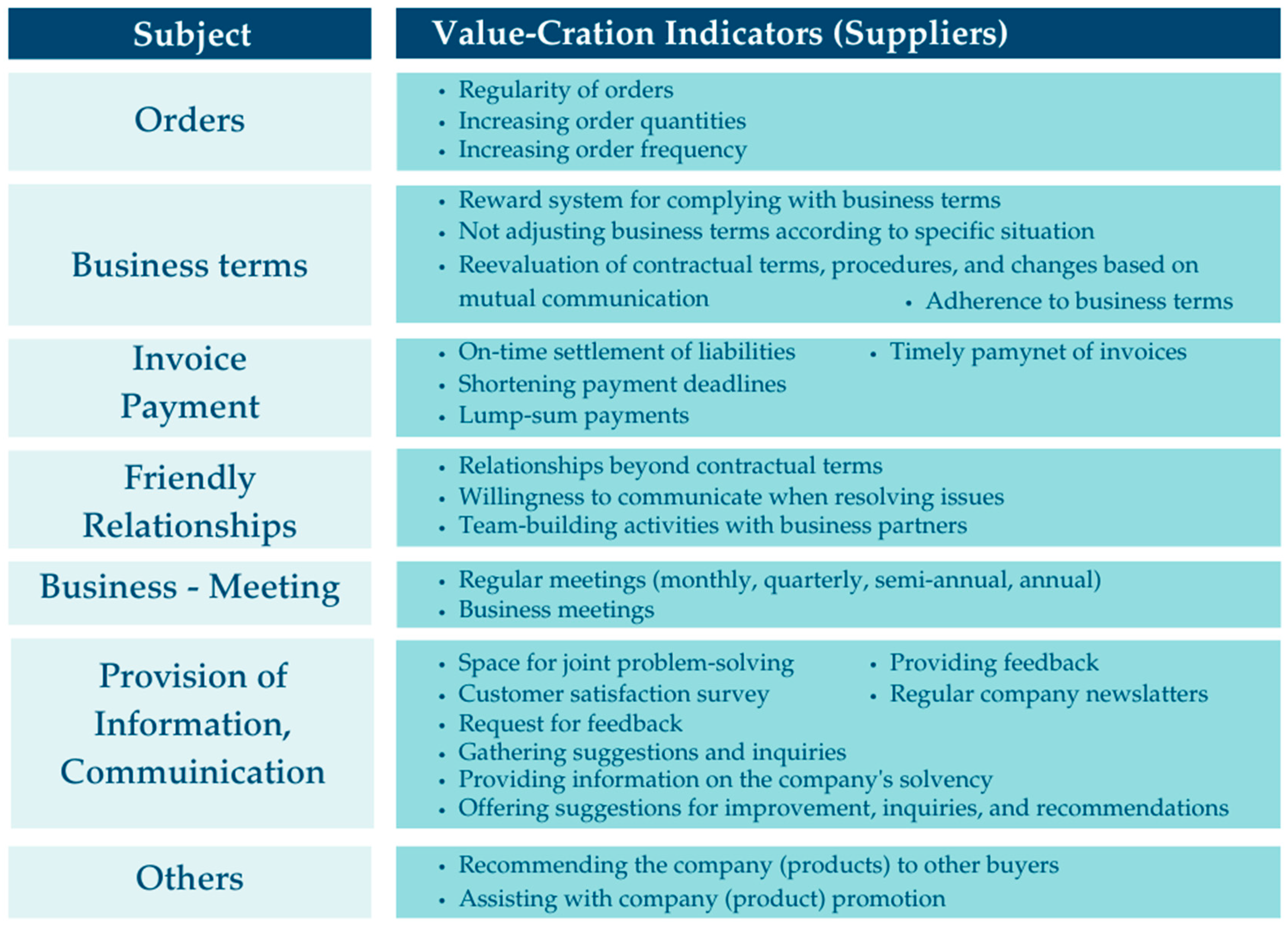
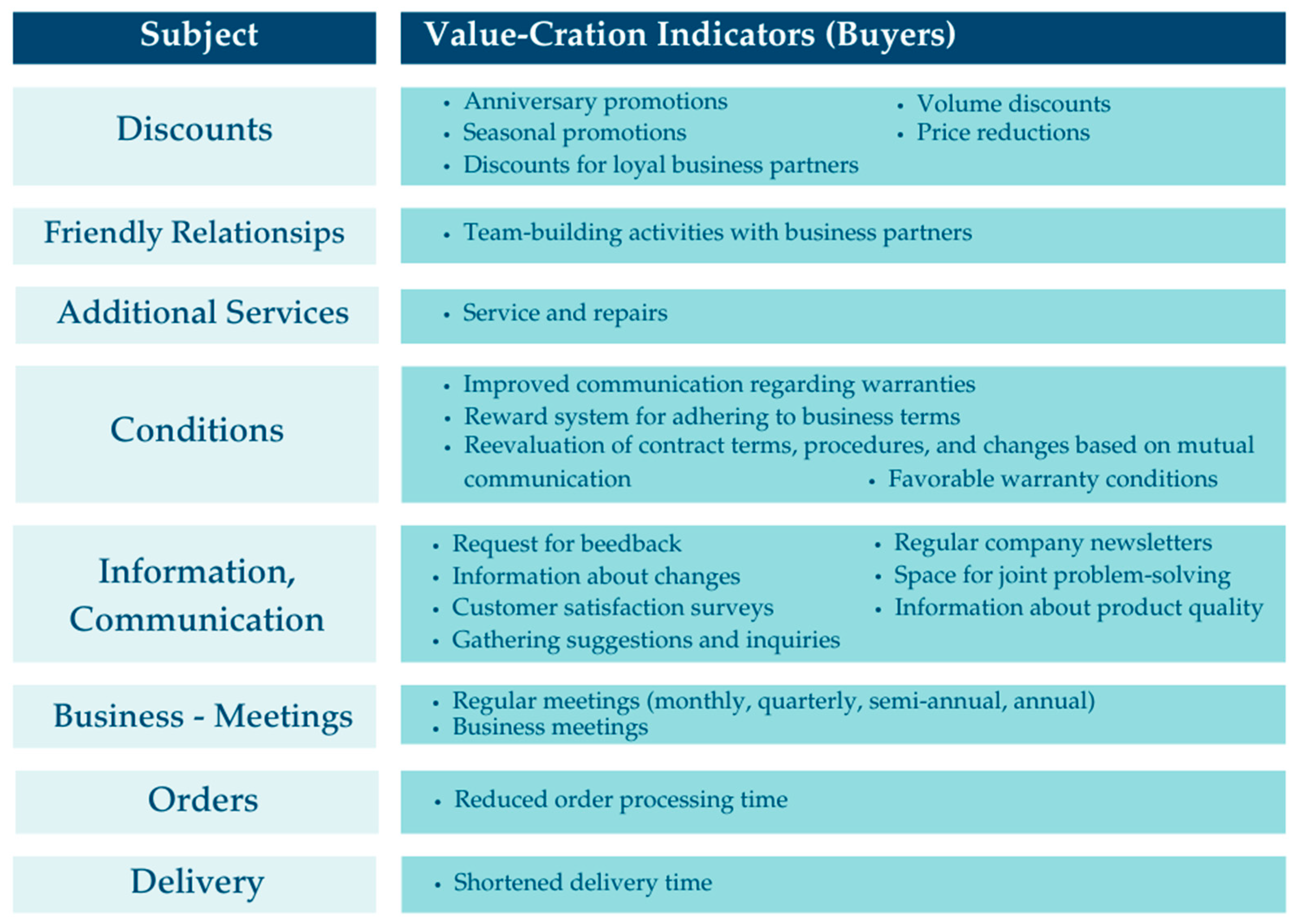
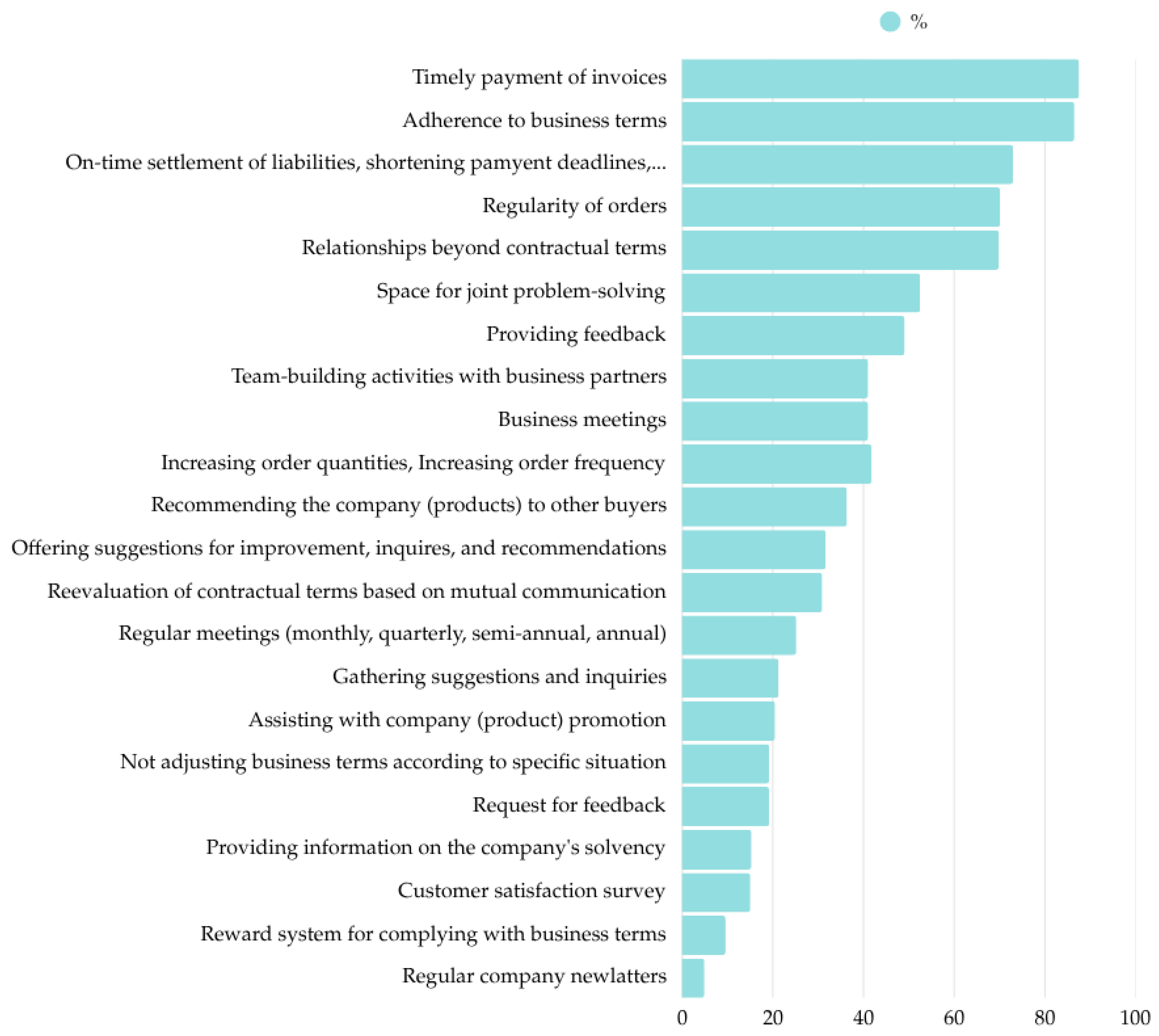

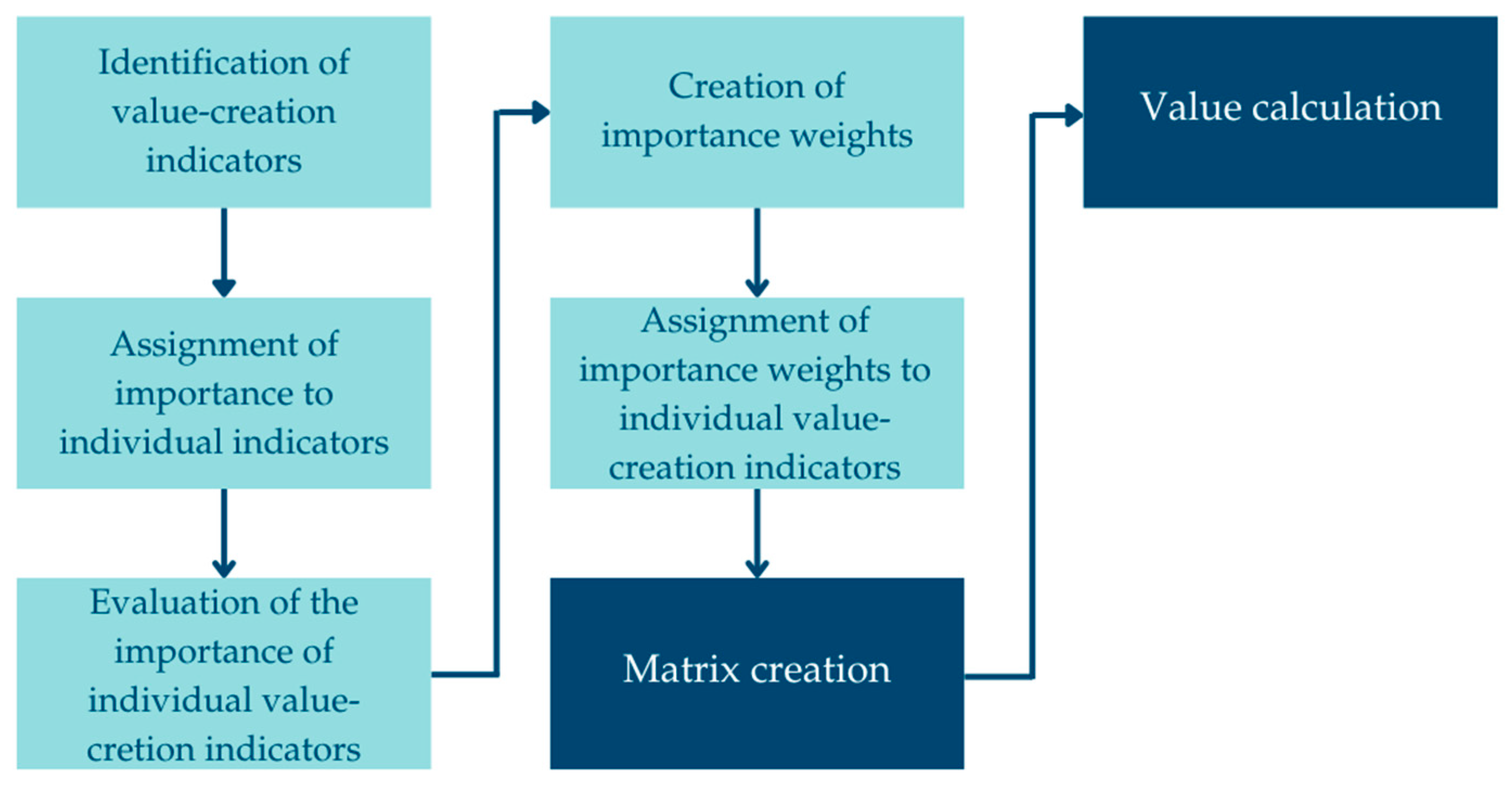

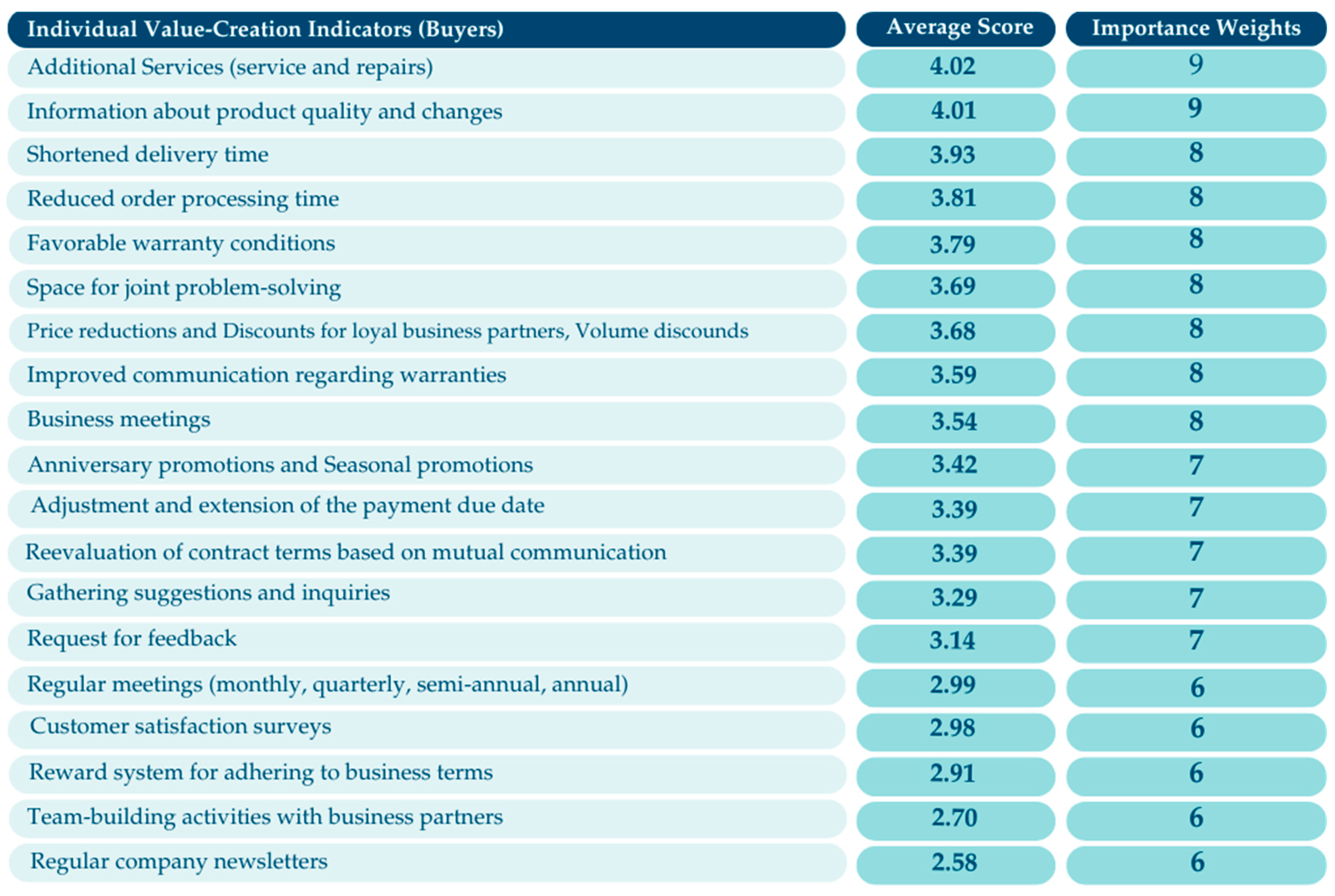
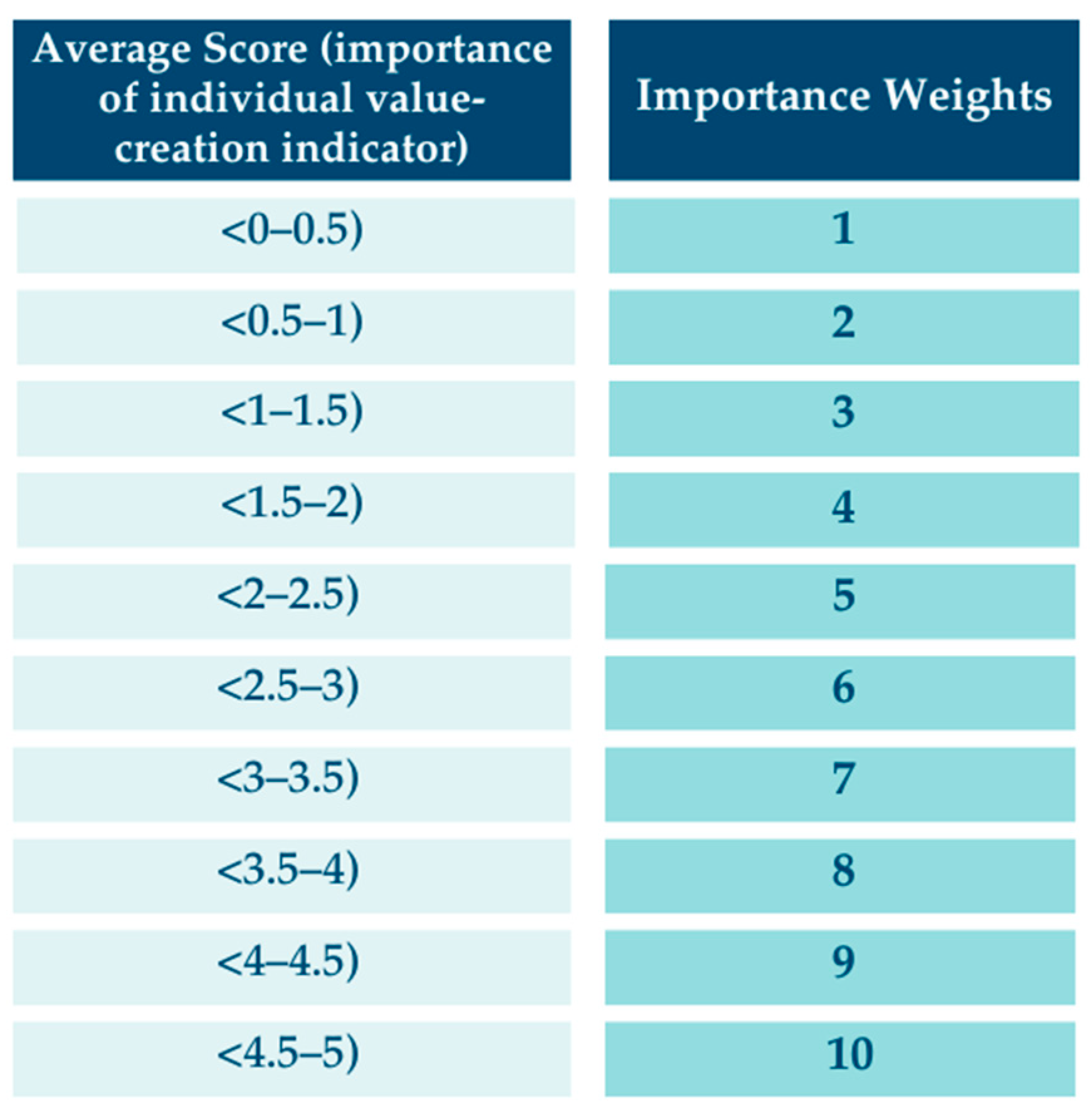

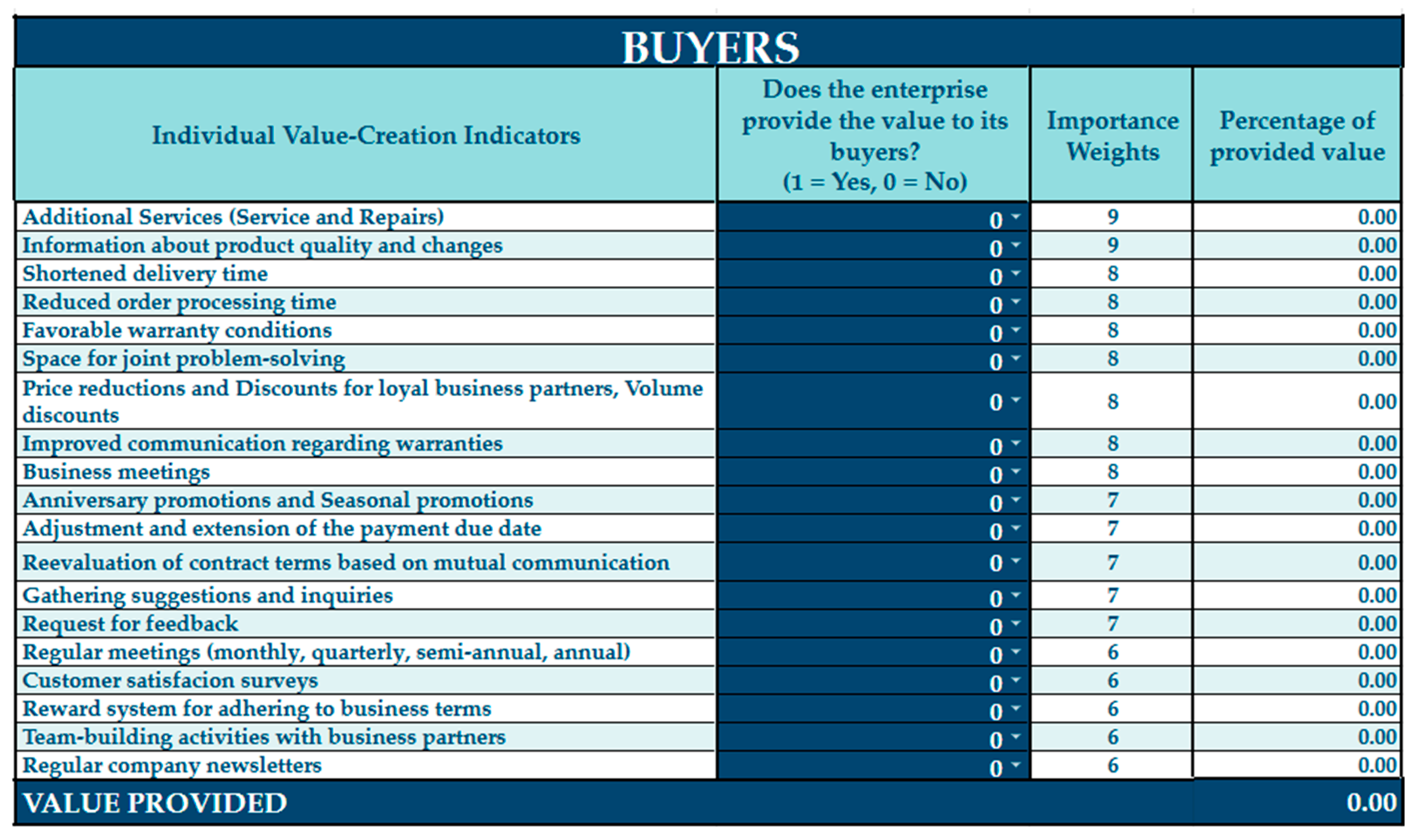

Disclaimer/Publisher’s Note: The statements, opinions and data contained in all publications are solely those of the individual author(s) and contributor(s) and not of MDPI and/or the editor(s). MDPI and/or the editor(s) disclaim responsibility for any injury to people or property resulting from any ideas, methods, instructions or products referred to in the content. |
© 2025 by the authors. Licensee MDPI, Basel, Switzerland. This article is an open access article distributed under the terms and conditions of the Creative Commons Attribution (CC BY) license (https://creativecommons.org/licenses/by/4.0/).
Share and Cite
Kusnirova, D.; Bubeliny, O.; Durisova, M. Measuring Created Value for Suppliers and Buyers: A Decision Matrix Approach—Evidence from Slovak Enterprises. Adm. Sci. 2025, 15, 226. https://doi.org/10.3390/admsci15060226
Kusnirova D, Bubeliny O, Durisova M. Measuring Created Value for Suppliers and Buyers: A Decision Matrix Approach—Evidence from Slovak Enterprises. Administrative Sciences. 2025; 15(6):226. https://doi.org/10.3390/admsci15060226
Chicago/Turabian StyleKusnirova, Dana, Oliver Bubeliny, and Maria Durisova. 2025. "Measuring Created Value for Suppliers and Buyers: A Decision Matrix Approach—Evidence from Slovak Enterprises" Administrative Sciences 15, no. 6: 226. https://doi.org/10.3390/admsci15060226
APA StyleKusnirova, D., Bubeliny, O., & Durisova, M. (2025). Measuring Created Value for Suppliers and Buyers: A Decision Matrix Approach—Evidence from Slovak Enterprises. Administrative Sciences, 15(6), 226. https://doi.org/10.3390/admsci15060226




